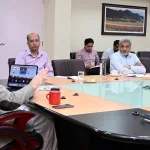In the daily noise of life, behind the veil of routine headaches and occasional eye strain, a quiet but dangerous storm was brewing inside me. It took nearly a decade to recognize that what I dismissed as “normal” was in fact the warning cry of a serious medical condition — a pituitary tumor.
For years, I lived with what I believed were minor discomforts: frequent headaches, pain behind the eyes, and fatigue that felt like the result of long hours on my phone or laptop. A nap or a dose of paracetamol would offer temporary relief. This cycle continued for nearly 7–8 years — a routine so familiar that I forgot to question it.
But I wasn’t alone. During my treatment, I met many others with similar experiences — individuals who, like me, had ignored the signs, misdiagnosed by a system not fully equipped to detect the silent advance of a Non-Functioning Pituitary Tumor (NFPT).
Unlike functioning tumors, NFPTs don’t secrete hormones. This often delays diagnosis until the tumor becomes large enough to press against critical areas, especially the optic nerve, causing gradual vision loss and neurological symptoms.
My medical journey was long and frustrating. I visited numerous healthcare centers — GMC Anantnag, Sub District hospital Tral, Bijbehara, and several private ophthalmology clinics in Srinagar. Each visit ended with a different theory: eye strain, migraine, screen exposure, or the need for new spectacles. No one considered a neurological cause.
It was only during a routine eye checkup at the Sub District Hospital Bijbehara that a sharp-eyed technician raised a red flag. After conducting thorough vision and pressure tests, he suggested that my problem might lie beyond the eye — perhaps in the brain — and recommended I seek further evaluation.
Still, more delays followed. One eye specialist in Srinagar told me everything was normal and simply advised me to reduce screen time. Meanwhile, my symptoms persisted and slowly worsened.
The real turning point came unexpectedly. While accompanying my mother for a check-up with Dr. Sheikh Nawaz, a neurologist, I mentioned my symptoms. He didn’t dismiss them. He listened — and immediately advised an MRI. That scan revealed the truth: a Pituitary Macroadenoma, large enough to compress my optic chiasm.
I was referred to PGI Chandigarh for urgent surgery. By then, my peripheral vision had started to decline — a terrifying realization of how close I had come to permanent damage.
The surgery itself was a success, but the post-operative journey wasn’t smooth. I suffered 14 episodes of epistaxis (nosebleeds). My hemoglobin levels dropped from 14.5 to just 6. A DSA test was conducted to rule out vascular complications. Thankfully, with proper care, I recovered.Now, Alhamdulillah, I’m back to living my normal life — but with a mission: to raise awareness and help others recognize what I almost missed.
Pituitary tumors don’t always shout—but they whisper consistently. And we must learn to listen. Watch out for:
- Persistent headaches that linger for months or years.
- Pressure or pain behind the eyes.
- Gradual loss of peripheral vision.
- Chronic fatigue or unexplained mood swings.
- Changes in menstrual cycles, libido, or other hormonal symptoms.
If these signs become frequent, don’t delay. Insist on deeper investigation. Push for an MRI. Demand a neurological consultation. Too often, patients are told they’re fine, even when the signs are loud and clear.
Early detection is everything. We need improved protocols in rural and district hospitals, better coordination between general physicians, ophthalmologists, and neurologists — and above all, public awareness.
Health systems must evolve from treating symptoms to identifying root causes. And as patients, we must not accept dismissals when something doesn’t feel right. It is better to be overcautious than regretful.
I’m a survivor, but I could have been diagnosed five years earlier. This delay cost me time, and health. Thankfully, my vision recovered after surgery—but it could have been a different story. I share my story not for sympathy, but as a warning — and a wake-up call.
When your body whispers, don’t wait for it to scream. A headache isn’t always just a headache. Sometimes, it’s the sound of a tumor growing quietly in the dark.
(Author is Faculty, GDC Awantipora and a Pituitary Tumor Survivor)








